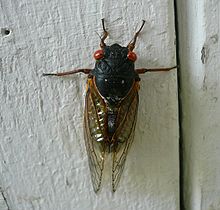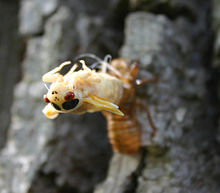
The cicadas are a superfamily, the Cicadoidea, of insects in the order Hemiptera. They are in the suborder Auchenorrhyncha, along with smaller jumping bugs such as leafhoppers and froghoppers. The superfamily is divided into two families, the Tettigarctidae, with two species in Australia, and the Cicadidae, with more than 3,000 species described from around the world; many species remain undescribed.

Brood X, the Great Eastern Brood, is one of 15 broods of periodical cicadas that appear regularly throughout the eastern United States. The brood's first major emergence after 2021 is predicted to occur during 2038.

The term periodical cicada is commonly used to refer to any of the seven species of the genus Magicicada of eastern North America, the 13- and 17-year cicadas. They are called periodical because nearly all individuals in a local population are developmentally synchronized and emerge in the same year. Although they are sometimes called "locusts", this is a misnomer, as cicadas belong to the taxonomic order Hemiptera, suborder Auchenorrhyncha, while locusts are grasshoppers belonging to the order Orthoptera. Magicicada belongs to the cicada tribe Lamotialnini, a group of genera with representatives in Australia, Africa, and Asia, as well as the Americas.

Charles Lester Marlatt (1863–1954) was an American entomologist. Born in 1863 at Atchison, Kansas, he was educated at Kansas State Agricultural College, where he was assistant professor for two years. He is the person who introduced the ladybug insect Chilocorus similis into the United States to control the San Jose scale insect, which was first discovered in San Jose, California in 1880 by John Henry Comstock and named by him. Marlatt worked for the Bureau of Entomology, United States Department of Agriculture. In 1912 he was appointed chairman of the Federal Horticultural Board. He was president of the Entomological Society of Washington in 1897–98 and of the American Association of Economic Entomologists in 1899.

Brood XIX is the largest brood of 13-year periodical cicadas, last seen in 2011 across a wide stretch of the southeastern United States. Periodical cicadas are often referred to as "17-year locusts" because most of the known distinct broods have a 17-year life cycle. Brood XIX is one of only three surviving broods with a 13-year cycle. It is also notable because it includes four different 13-year species, one of which was discovered in Brood XIX in 1998 by scientists listening to cicada songs.

Magicicada cassini, known as the 17-year cicada, Cassin's periodical cicada or the dwarf periodical cicada, is a species of periodical cicada. It is endemic to North America. It has a 17-year life cycle but is otherwise indistinguishable from the 13-year periodical cicada Magicicada tredecassini. The two species are usually discussed together as "cassini periodical cicadas" or "cassini-type periodical cicadas." Unlike other periodical cicadas, cassini-type males may synchronize their courting behavior so that tens of thousands of males sing and fly in unison. The species was first reported to the Academy of Natural Sciences of Philadelphia by Margaretta Morris in 1846. In 1852, the species was formally described by J. C. Fisher and given the specific name cassini in honour of John Cassin, an American ornithologist, whose own report was included by Fisher in his publication.

Magicicada septendecim, sometimes called the Pharaoh cicada or the 17-year locust, is native to Canada and the United States and is the largest and most northern species of periodical cicada with a 17-year lifecycle.

Pyemotes herfsi, also known as the oak leaf gall mite or itch mite, is an ectoparasitic mite identified in Western Canada in 1923 and subsequently found in India, Asia, and the United States. The mite parasitizes a variety of insect hosts and bites humans, causing red, itchy, and painful wheals (welts). The mites are barely visible, measuring about 0.2–0.8 millimeters; their great reproductive potential, small size, and high capacity for dispersal by wind make them difficult to control or avoid.

Massospora cicadina is a fungal pathogen that infects only 13 and 17 year periodical cicadas. Infection results in a "plug" of spores that replaces the end of the cicada's abdomen while it is still alive, leading to infertility, disease transmission, and eventual death of the cicada.

Brood XIV is one of 15 separate broods of periodical cicadas that appear regularly throughout parts of the midwestern, northeastern, and southeastern United States. Every 17 years, the cicadas of Brood XIV tunnel en masse to the surface of the ground, mate, lay eggs, and then die off in several weeks.

Pyemotes tritici is a species of mite known as the grain itch mite or straw itch mite. It is a cosmopolitan species that is found on straw, hay and stored grain. It is a parasite of small arthropods and is being investigated as a possible biological control of stored product pests. It is associated with dermatitis in humans, and it causes an itchy rash.
Magicicada neotredecim is the most recently discovered species of periodical cicada. Like all Magicicada species, M. neotredecim has reddish eyes and wing veins and a black dorsal thorax. It has a 13-year life cycle but seems to be most closely related to the 17-year species Magicicada septendecim. Both species are distinguished by broad orange stripes on the abdomen and a unique high-pitched song said to resemble someone calling "weeeee-whoa" or "Pharaoh." They differ only in life cycle length.

Magicicada tredecim is a 13-year species of periodical cicada, closely related to the newly discovered 13-year species Magicicada neotredecim, from which it differs in male song pitch, female song pitch preferences, abdomen color, and mitochondrial DNA. Both M. tredecim and M. neotredecim are closely related to the 17-year species M. septendecim, which was identified by Linnaeus in 1758; these three species are often grouped together under the name decim periodical cicadas.

Decim periodical cicadas is a term used to group three closely related species of periodical cicadas: Magicicada septendecim, Magicicada tredecim, and Magicicada neotredecim. M. septendecim, first described by Carl Linnaeus, has a 17-year life cycle; the name septendecim is Latin for 17. M. tredecim, first described in 1868, has a similar call and appearance but a 13-year life cycle; tredecim is Latin for 13. M. neotredecim, first described in 2000 by Marshall and Cooley in an article in the journal Evolution, is a 13-year species but otherwise much more similar to M. septendecim than to M. tredecim as shown by studies of DNA and abdominal color variation by Chris Simon and colleagues in a companion article in the same journal issue.

The Cassini periodical cicadas are a pair of closely related species of periodical cicadas: Magicicada cassini, having a 17-year life cycle, and Magicicada tredecassini, a nearly identical species with a 13-year life cycle.

Brood II is one of 15 separate broods of Magicicada that appear regularly throughout the northeastern United States. Every 17 years, Brood II tunnels en masse to the surface of the ground, mates, lays eggs, and then dies off over the span of several weeks.

Brood XXII is a brood of 13-year periodical cicadas, last seen in 2014 in a geographic region centered on Baton Rouge, Louisiana, as well as other locations in southeast Louisiana and southwest Mississippi. Periodical cicadas are often referred to as "17-year locusts" because most of the known distinct broods have a 17-year life cycle. Brood XXII is one of only three surviving broods with a 13-year cycle. The next emergence of The Baton Rouge Brood is expected in 2027.
Brood XI was a brood of periodical cicadas that appeared regularly in the eastern United States. It was one of the smallest 17-year broods, consisting exclusively of the species Magicicada septendecim, and was historically restricted to areas of Connecticut, Massachusetts, and Rhode Island which appeared to be at the northern limit of the species' range. Brood XI has not been seen since its 1954 emergence and is now generally regarded as extinct.
Brood IX, is one of 15 broods of periodical cicadas that appear regularly throughout the United States in 13 or 17-year intervals. Seventeen-year Brood IX is concentrated in Virginia, West Virginia, and North Carolina.

Brood XXIII is a brood of 13-year periodical cicadas that last emerged in 2015 around the Mississippi River in the states of Louisiana, Mississippi, Arkansas, Tennessee, Missouri, Kentucky, and Illinois. The brood was also seen in Southwestern Indiana and Western Kentucky around the Ohio River, and as far north as Weldon Springs State Park in DeWitt County, Illinois. Brood XXIII is one of three extant periodical cicada broods with a 13-year life cycle, and thus is expected to be seen again in 2028.






















